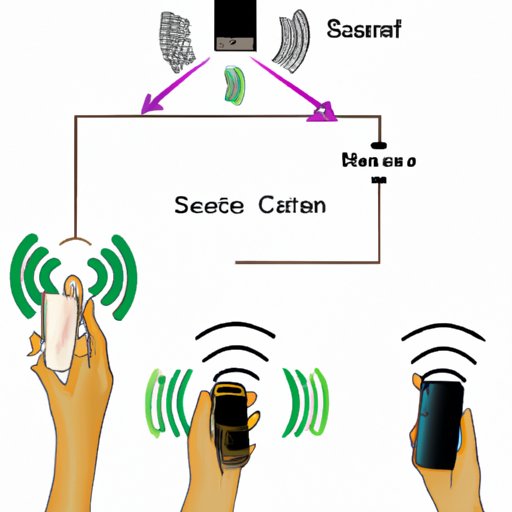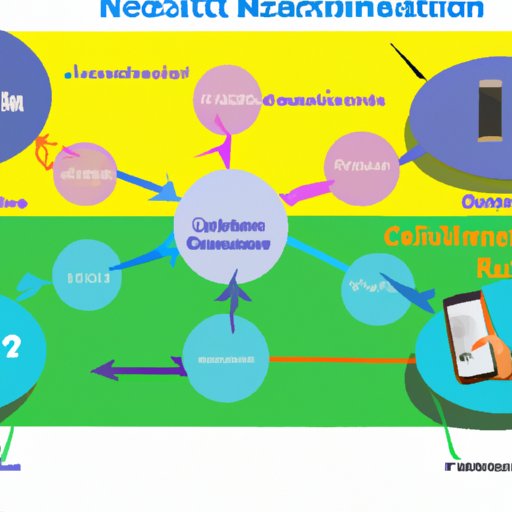Introduction
A cell phone is a handheld device that enables users to make and receive telephone calls, send text messages, access the internet, and take pictures. In this article, we will explore the different aspects of a cell phone and how it works. We will look at the physical components, the role of radio frequency waves, the various network technologies, the different types of apps available, the role of network providers, the impact of cell phone technology on society, and the security risks associated with cell phone use. Finally, we will examine the latest technological advances in cell phone technology and their impact on the marketplace.
Exploring the Hardware Components of a Cell Phone
The physical components of a cell phone include the battery, display, audio speaker, microphone, antenna, and circuit board. Each component plays an important role in the operation of the cell phone. The battery provides power to the device and can be recharged when needed. The display allows users to view information such as incoming calls, text messages, and web pages. The audio speaker and microphone enable users to speak and listen to others during conversations. The antenna helps to transmit and receive signals from the network. The circuit board contains the processor and other electronic components that control the operation of the cell phone.

How Signals are Sent and Received by a Cell Phone
Cell phones use radio frequency waves to send and receive data. These waves travel through the air and are picked up by antennas located on nearby cell towers. When a user makes a call or sends a text message, the signal is sent to the nearest cell tower, which then transmits the signal to its destination. When a call or text message is received, the signal is sent from the cell tower to the user’s cell phone. This process happens very quickly and is what allows for instant communication between two people.

Understanding the Role of Different Software Applications in Cell Phone Functionality
Software applications, commonly referred to as “apps”, are an integral part of a cell phone’s functionality. Apps range from simple games and calculators to complex productivity tools and social media platforms. Different operating systems, such as iOS and Android, can support different types of apps. Operating systems also offer features such as multitasking, which allow users to run multiple apps at the same time.

Examining the Role of Network Providers in Cell Phone Functioning
Network providers, such as AT&T and Verizon, play an important role in the operation of cell phones. They provide coverage to areas that are within their network’s reach and offer different levels of service quality depending on the type of plan that is chosen. Consumers should research the different networks to determine which one offers the best coverage and service quality for their particular needs.
Investigating the Impact of Cell Phone Technology on Society
Cell phones have had a significant impact on society. Mobile phones have made it easier for people to stay connected with each other and access information and services from anywhere. However, there are also some negative impacts, such as increased distraction and decreases in face-to-face interaction.

Analyzing the Security Risks Associated with Cell Phone Use
Cell phones can also pose security risks if not properly secured. The most common risks include malware, phishing scams, and unsecured Wi-Fi networks. To reduce these risks, users should always keep their software and apps up to date, use strong passwords, and avoid connecting to unknown or unsecured Wi-Fi networks.
Exploring the Latest Technological Advances in Cell Phone Technology
The latest technological advances in cell phone technology include the introduction of 5G networks, augmented reality, and artificial intelligence. These advancements have enabled faster data speeds, improved gaming and video streaming experiences, and more powerful voice recognition capabilities. Smartphones have become increasingly popular due to their ability to offer these advanced features in a compact form factor.
Conclusion
In conclusion, cell phones are complex devices that rely on a combination of hardware, software, and network providers to function. By understanding the different components and how they interact, users can better understand how a cell phone works. Additionally, it is important to be aware of the potential security risks associated with cell phone use and take steps to reduce them. Finally, the latest technological advances in cell phone technology have enabled new capabilities and enhanced user experiences.
(Note: Is this article not meeting your expectations? Do you have knowledge or insights to share? Unlock new opportunities and expand your reach by joining our authors team. Click Registration to join us and share your expertise with our readers.)
